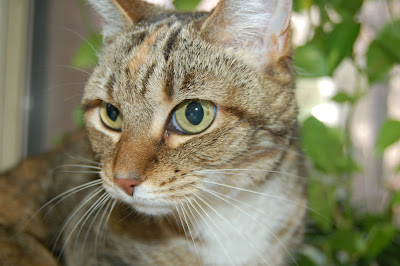Question:
Gracie, our 8-year old, spayed female DSH has just been diagnosed with hyperthyroidism, based on the finding of a high serum T4 value (12.4 μg/dl; reference range, 1-4.7 μg/dl). We only did her blood work in anticipation of a dental cleaning, and are shocked by this news.
Gracie has no symptoms whatsoever of this disorder. She eats and drinks a normal amount; her diet has been mostly high quality, grain-free dry food (she never liked or ate canned until very recently, also grain-free). She has shown slight weight loss, but only because she was overweight and we were controlling her intake — trying to get her to loose weight. Her behavior and attitude are positive; no change from before. Her coat, skin, and eyes all fine. Hydration is fine. Digestion and bowels fine (no vomiting, no diarrhea). Just some bad breath (hence the dental).
Our vet feels nothing upon palpation of her thyroid. If anything, she may have a slightly high heart rate (212 beats per minute taken at vet's...possibly nerves), but her blood pressure was fine (averaged 128/77 out of 5 readings).
We had the T4 test run a second time at a different lab and it came back high again at 11.2 μg/dl.
My question to you is this....in your years of experience with hyperthyroidism, has there ever been an occasion when the T4 values have receded on their own, without medication or irradiation? I ask this because Gracie is so young and has no symptoms.
I would not want to irradiate her thyroid if there is any possibility of this being a "passing phase" in her life. However, I am quite aware of the dangers and complications of hyperthyroidism, and do not want to play around with her health. With everything else so "normal," I would be willing to wait a month or two and recheck her if you think there's any hope in doing so. Are you aware of any current research indicating that T4 numbers can fluctuate in a young cat? More than any other factor, it is her young age that makes me question whether these T4 readings are permanent.
My Response:
No, I've never seen a hyperthyroid cat go into remission. Cats with hyperthyroidism all have one or more benign thyroid nodules, generally benign tumors or adenomas (see Figure below). These thyroid tumors will not go away spontaneously once they have formed (1-4). The only way to cure this disease is by use of radioiodine (I-131) to irradiate the adenomatous thyroid nodule(s), or by use of surgery to remove the abnormal thyroid gland (1-6).
 |
| Palpating a large thyroid nodule (adenoma) in a hyperthyroid cat |
It's sounds like you think that a cat of 8-year's of age is too young to develop hyperthyroidism. But we do occasionally see cats as young as 6 years of age, and very rarely, even as young as a year or two (1-4,7).
That all said, I'm bothered that your veterinarian is not able to palpate an enlarged thyroid tumor with a T4 value that is clearly quite high. You might want to have another veterinarian palpate Gracie's neck to see if they can identify one or more thyroid nodules. If they cannot and the serum T4 remains high, it would be very useful to do thyroid scintigraphy (ie, a thyroid scan) to document the presence or absence of a thyroid tumor. Thyroid scintigraphy is the most sensitive diagnostic test we have to confirm the presence of hyperthyroidism in cats (8-10), and we use this procedure routinely in my practice.
You certainly could monitor the T4 value again in a month or two, especially since Gracie is stable. But it certainly does sound like she has hyperthyroidism and will need to be treated at some time in the near future.
References:
- Peterson ME: Hyperthyroidism, In: Ettinger SJ, Feldman EC (eds): Textbook of Veterinary Internal Medicine: Diseases of the Dog and Cat (Fifth Edition). Philadelphia, WB Saunders Co. 2000; pp 1400-1419.
- Peterson ME: Hyperthyroidism in cats. In: Melian C (ed): Manual de Endocrinología en Pequeños Animales (Manual of Small Animal Endocrinology). Multimedica, Barcelona, Spain, 2008, pp 127-168.
- Baral R, Peterson ME. Thyroid gland disorders. In: Little, S.E. (ed), The Cat: Clinical Medicine and Management. Philadelphia, Elsevier Saunders 2012; 571-592.
- Mooney CT, Peterson ME: Feline hyperthyroidism, In: Mooney C.T., Peterson M.E. (eds), Manual of Canine and Feline Endocrinology (Fourth Ed), Quedgeley, Gloucester, British Small Animal Veterinary Association, 2012; in press.
- Peterson ME: Radioiodine treatment for hyperthyroidism. Clinical Techniques in Small Animal Practice 2006;21:34-39.
- Peterson ME, Broome MR: Radioiodine for hyperthyroidism. In: Bonagura JD, Twedt DC (eds): Current Veterinary Therapy XV. Philadelphia, Saunders Elsevier, 2012, in press.
- Broussard JD, Peterson ME, Fox PR. Changes in clinical and laboratory findings in cats with hyperthyroidism from 1983 to 1993. Journal of the American Veterinary Medical Association 1995;206:302-305.
- Broome MR. Thyroid scintigraphy in hyperthyroidism. Clinical Techniques in Small Animal Practice 2006; 21:10-16.
- Daniel GB, Brawnier WR. Thyroid scintigraphy In: Daniel GB, Berry CR, eds. Textbook of Veterinary Nuclear Medicine. 2nd ed. Harrisburg, PA: American College of Veterinary Radiology, 2006;181-199.
- Peterson ME, Broome MR. Thyroid scintigraphic findings in 917 cats with hyperthyroidism. Journal of Veterinary Internal Medicine 2012; in press.










Không có nhận xét nào:
Đăng nhận xét